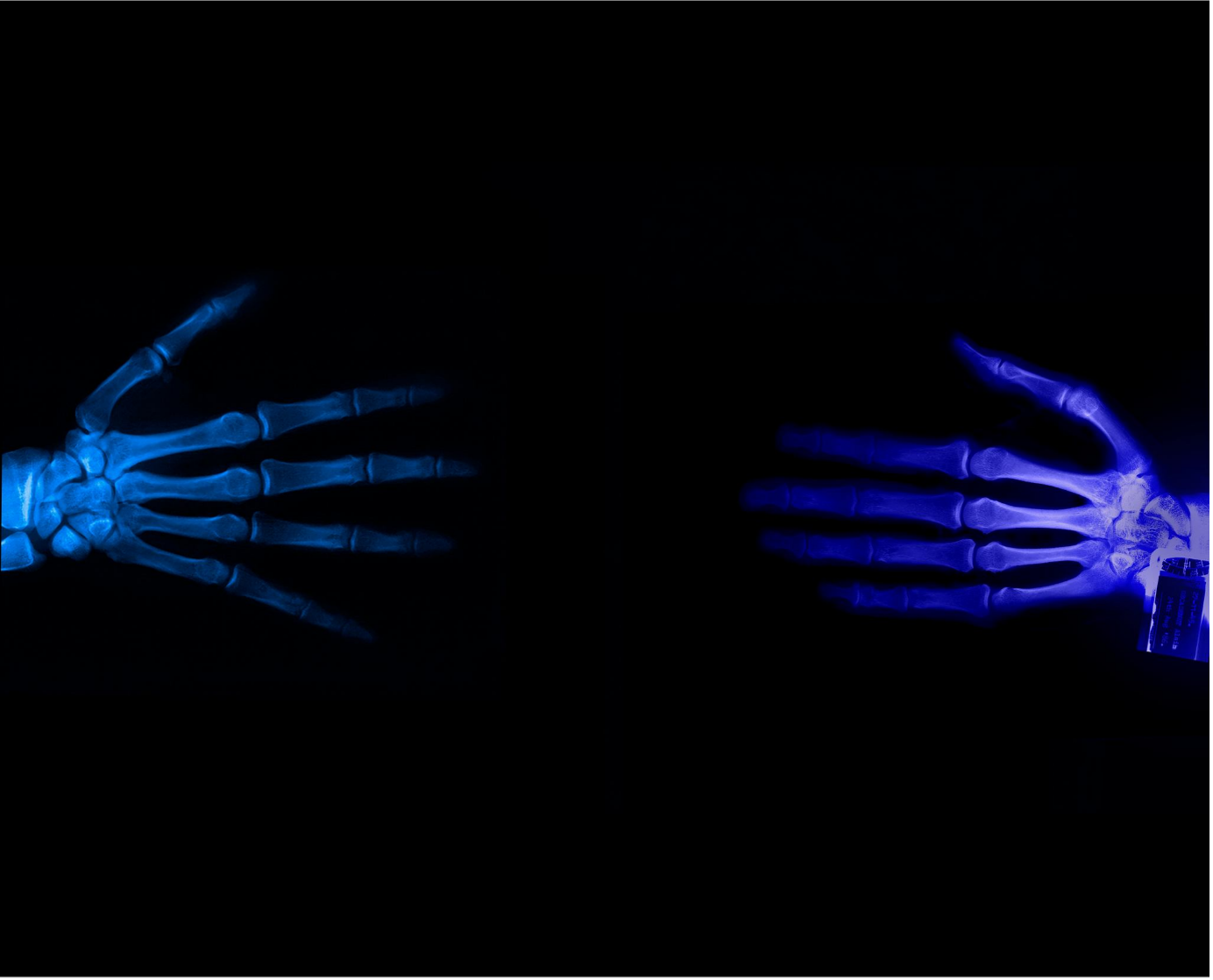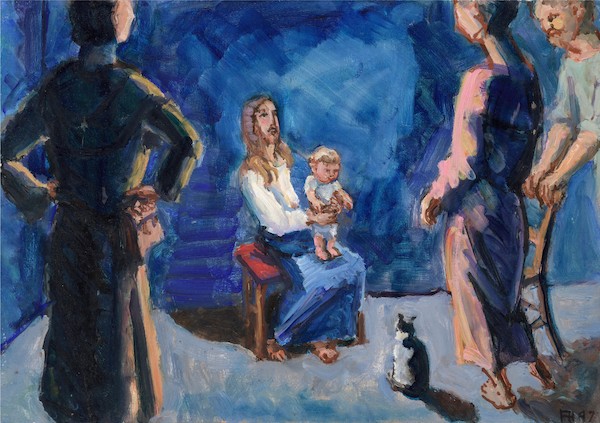
Basil Spence described Coventry Cathedral as a plain jewel casket filled with many jewels. St Aidan’s East Acton, which has been described as a small echo of Coventry, is designed on a similar basis. In other words the church is architecturally plain – essentially a white rectangle – with the aim that this simplicity and minimalism will show off the artworks to best effect and that the significance and impact of these works will bring the building to life as a place of worship.
St. Aidan's was founded in 1922 but the current building was erected in 1961 by John Newton in brick and concrete with an open bell tower. The artworks, commissioned by then parish priest Fr. James Ethrington, which are the jewels in the casket, include: Saints carved in limewood by Arthur JJ Ayres, George Campbell, Philip Lindsey Clark and Kathleen Parbury; Christ Crucified altarpiece by Graham Sutherland; Sacred Heart and Our Lady of Walsingham triptychs by Roy de Maistre; sanctuary and porch stained glass windows by Pierre Fourmaintraux; Stations of the Cross in concrete by Arthur Fleischmann; ceramic wall to baptistery with design by Adam Kossowski.
Ben Read in his 1998 lecture to the Royal Society of British Sculptors uses St Aidan’s East Acton as an example of the alternative culture of church art that we find in the UK following the Second World War:
‘Churches were being repaired. New work was being installed in them. There was an expansion of church buildings with works of art in them … There is an alternative world there of the commissioning of art for specific purposes that, with no disrespect to established art historians, simply doesn't feature in our notion of cultural history in the post-war period.’ (www.fleischmann.org.uk/frrefe.html)
St Aidan’s also illustrates two further trends within this alternative culture. The first is that the Church in Britain frequently used the skills and creativity of émigré artists including Ernst Blensdorf, Marian Bohusz-Szyszko, Ervin Bossanyi, Georg Ehrlich and Hans Feibusch, among others.
Here, there is work by Arthur Fleischmann, Pierre Fourmaintraux, Adam Kossowski and Roy de Maistre. Fleischmann was born in Bratislava in 1896, but lived most of his life in London. He studied medicine in Budapest and Prague and qualified as a medical doctor but then turned his attention and energy to sculpture and was awarded a scholarship to the Master School of Sculpture, Vienna. In 1937 he travelled to South Africa, Indonesia and Bali, from where he was forced to flee to Australia as the Japanese invaded. He arrived in Sydney in 1939 where he stayed for 10 years becoming part of the Merioola artist commune. In 1949 he travelled to England with plans to return to Bratislava, but met his wife Joy in London and made it his home for over 40 years. He quickly established himself as a portrait sculptor in London, completing portrait busts of Popes Pius XII, John XXIII, Paul VI and John Paul II from life. Devotion to the Catholic Church was central to his work with a major part of his creative output being of religious themes. He received around 22 church commissions including the Stations of the Cross here which are set against a mosaic frieze which surrounds much of the building.
Adam Kossowski quickly made a career in public works of figurative art after arriving in Britain in 1943. His Catholic background brought him large numbers of church commissions many of which, as here, were ceramic bas-reliefs. Working in clay enabled Kossowski to create with a greater sense of 3D animation as well as the expressiveness he was able to achieve by marking or cutting into the clay. As each panel was also painted, these effects were combined with all the variation, shade and harmonies achievable through paint. As stated on the Ecclesiart web pages, he undertook this work ‘with exceptional stylistic integrity and a sophisticated theological understanding’.

Pierre Fourmaintraux’s stained glass at St Aidan’s is in the dalle de verre style, consisting of abstract designs made of thick, small, dark pieces of glass set in concrete. The jewelled porch windows represent ‘the growth of the church in England from the missionary struggle of Roman times, through the flowering of the Middle Ages, the Reformation, and the Second Spring up to the struggle today against industrial materialism,’ while on either side of the sanctuary various English saints stand guard.

Roy de Maistre explored the relationship between art and music in Australia's first abstract paintings, characterised by high-key colour, large areas of flat paint and simplified forms. De Maistre's theory of colour harmonization, based on analogies between colours of the spectrum and notes of the musical scale, also aligned with his search for spiritual meaning through abstraction. As we will consider further in a moment, the relevance of religious themes was magnified by the Second World War and drew the attention of major artists including de Maistre, Graham Sutherland, Henry Moore and Francis Bacon in Britain and Arthur Boyd, Sidney Nolan and Ian Fairweather in Australia. ‘De Maistre had painted major religious works prior to the Second World War such as The Crucifixion 1932-45 (in the collection of the Art Gallery of New South Wales, Sydney), but it was during the immediate post-War years that he produced his most important works including Stations of the Cross for Westminster Cathedral’ and the triptychs here (www.bonhams.com/auctions/21282/lot/112).

Graham Sutherland's Crucifixion, unveiled in 1963, was the third he had created for a church and the first and only commission that he received from a Roman Catholic Church, despite being a Catholic himself. It taps another theme found within the revival of sacred art, a focus on the horror of crucifixion. For Sutherland this derives from reflection on the terror inherent in both Grünewald’s Isenheim altarpiece and the reality of the Holocaust. First seen in sacred art in Stations of the Cross by Albert Servaes, which were removed following a Holy Office decree from a Carmelite chapel in Luithagen, such depictions of the crucifixion have caused scandal because, as Titus Brandsma wrote of Servaes’ Stations, we ‘do not even dare to behold the sufferings of which we ourselves are the cause.’
Similar reactions have been recorded to Sutherland’s Christ Crucified at St Aidan’s. Tony Kirwan wrote in the Catholic Herald that ‘Sutherland's taut and terrible Crucifixion: today's Christ against a red brick wall, under an electric light … is a constant reminder to the parishioners of St Aidan's, East Acton, that Christ is crucified today if they care to look’ (http://archive.catholicherald.co.uk/article/25th-june-1976/3/parish-and-community-no-11-st-aidans-east-acton). Anthony P. Kirwin in 1964 interviewed members of the youth club at St Aidan’s about the impact on them of Sutherland’s Crucifixion. Many of those interviewed confirmed Sutherland’s contention ‘that youth far more readily apprehend a painter's intention and the impact of his work’:
• ‘To me it brings out the brutal aspect of Christ's death more than any other painting I've ever seen: the brutality, not the usual attractive body. It's quite fantastic the way the chest is brought right up to really show the suffering. This is what I really like about it. Sutherland hasn't tried to over-glorify the death of Christ at all, he's shown it as it really was, brutal.’
• ‘I didn't used to think the Crucifixion was like the painting says. But when you think back it is really what it was like.’
• "A 'nice' painting doesn't give you any feelings at all, but that one really makes you think about the crucifixion of Jesus."
• ‘The painting shows you the inhumanity and brutality of men. It shows you the human race as it really is.’
When I visited for a mid-week morning Mass led by Associate Priest, Fr. Christopher McAneny, I was kindly invited to stay for refreshments by white-haired Anna who admitted that when she first came into the church, she didn't like the Sutherland painting at all. Now, she told me, she does like it. It seems that often these scandals of modern art, whether the reception of the works themselves or that of their challenging content, with time are resolved as congregations live with the works and learn to value the challenge of what initially can seem to be scandalous.
As a result it seems a shame that this parish (in common with some others which have in the past commissioned significant artworks) appear to make no particular efforts to make the existence of these works more widely known or appreciated. Neither the church building or its website seem to contain information about either the commissions or the artists who had created them. The cluster of Catholic Herald articles from the 1960s and 70s about the parish and its artworks would seem to show that initially there was a sense, presumably now lost, that these commissions were both for the local congregation and also part of a wider ministry within the Church and society.
**********
St Aidan of Lindisfarne, Acton East Parish
Old Oak Common Lane
East Acton
Tel: 020 8743 5732.
Email: actoneast@rcdow.org.uk.
Web: parish.rcdow.org.uk/actoneast
%20(1).png)












